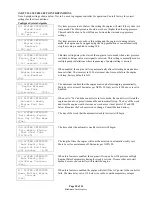
Page 8 of 34
File Name:
Doc#586p.docx
h.
AUTOMATIC STARTING TESTS:
1.
Place control in
"Auto"
position.
2.
Bleed off pressure in system until pressure drops below the low set point. The
“Pump on Demand”
light should come
on.
3.
Engine should start automatically and continue to run after pressure rises above the high set point, if arranged for
"Manual"
stop. If arranged for
"Automatic"
stop, engine will continue to run for time set on Engine Run Timer and
then stop.
4.
Press the
"Stop"
push button to stop the engine.
5.
Repeat tests for each demand switch such as deluge valve, remote start, etc.
i.
PERIODIC WEEKLY START TEST:
1.
Pressure must be up and all other demand switches de-activated.
2.
115 V.A.C. power must be turned on to the panel.
3.
When the current day and time of day matches the settings in System Config screens 107 and 108, the solenoid drain
valve will energize and the engine will begin cranking. It will continue to run for the amount of time set.
4.
Should a remote manual start occur or a low pressure condition occur while the pump is running on Weekly Test, the
pump will not stop until the Stop pushbutton is pressed or if set for Automatic Stop, the Minimum run timer times out.
5.
The periodic Weekly Test function is factory set to No in Screen 106 due to Factory Mutual standard requirements.
Contact the Metron Factory Service department for instructions to turn this function on if this is not a Factory Mutual
insured facility.
j.
SETTING PROGRAM WEEKLY TEST TIME:
System Config screen 106 through 109.
k.
REMOTE START SWITCH CIRCUITS:
Field wiring terminals are provided on the controller so that optional remote
start switches such as Remote Pushbutton Stations, Deluge Valve Switch, Fire Alarm Switches, etc., may be used to start
the engine. Two (2) sets of terminals are provided. Terminals #112 and #31 are used for remote manual start push buttons
(close to start). Terminals #111 and #31 are used for remote Deluge Valve Switch or other remote automatic start switches
(open to start). Upon automatic start from this type of switch, the engine will be stopped either automatically (if set for
automatic stop) after the demand switch de-activates and Engine Auto Stop Timer times out, or manually at the Controller.
Terminals #111 and #31 must have a jumper installed if a remote Deluge switch is “Enabled” but not to be used. When the
controller is shipped from the factory Deluge Valve start is Disabled (System Config screen 121).
l.
AC POWER FAILURE STARTING:
If this feature has been enabled it can be tested by disconnecting the normal 115
V.A.C. to the Controller. After the preset time delay (which is specified in System Config screen 112), the Controller will
commence cranking the engine. The
"Charger #1 Failure”, “Charger #2 Failure”, and “AC Power Loss"
lamps will
illuminate and the alarm will sound without delay.
m.
NORMAL OPERATION – AUTOMATIC:
Turn the selector switch to the “
Auto"
position. A green
"Automatic
Mode"
light will illuminate and the engine will automatically start upon drop in pressure or operation of other start
switches. If the Auto Stop Timer is disabled (Manual Stop) the engine must be turned off at the Controller. When the Auto
Stop Timer is enabled, upon termination of the demand signal, the engine will run for the length of time left on the Auto
Stop Timer and then will stop automatically.
n.
AN ADJUSTABLE SEQUENTIAL START TIMER IS SUPPLIED FOR MULTIPLE PUMP INSTALLATION:
Normally, the leading pump Controller will not have a delay timer and will commence cranking the engine immediately
upon operation of a demand signal (other than Power Failure which is time delayed). The subsequent Controllers will have
a time delay which is adjustable from 0 to 999 seconds. Each time delay should be set with progressively longer times on
each subsequent pump. The recommended time interval is ten (10) to fifteen (15) seconds. This may be extended or
shortened as required by the local authorities having jurisdiction.
o.
PUMP ROOM ALARMS:
Field terminals may be provided for various inputs from pump room alarms. These alarms
include: Low Fuel, Low Pump Room Temperature, Reservoir Low, Reservoir Empty, Low Suction Pressure, Relief Valve
Discharge and/or Flow Meter On etc. A maximum of ten (8) pump room alarms are available. The Controller is arranged so
that the alarm horn will sound and the light will come on when the alarm sensor contacts close. These pump room alarms
can be silenced with the “Silence” push button on the OID if they have been configured as silenceable.









































